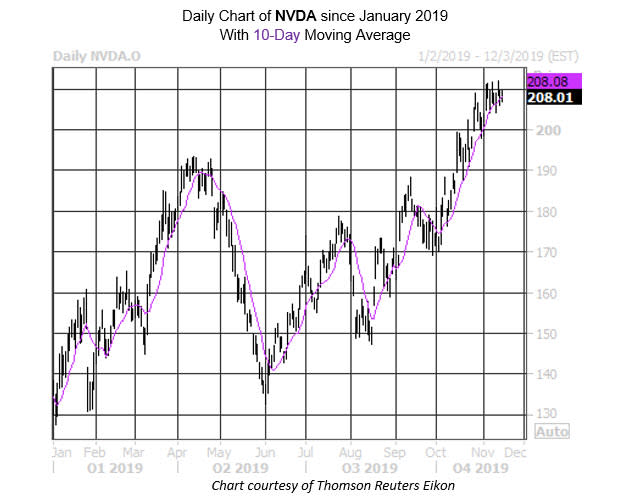Options Traders Load Up On Nvidia Calls Ahead of Earnings
Earnings season isn't over yet. After the close tonight, semiconductor concern Nvidia Corporation (NASDAQ:NVDA) will step into the earnings confessional for its third-quarter report. Ahead of the event, NVDA is down 0.3% to trade at $208.01 today, up 40% in the past three months, with its ascending 10-day moving average providing support since September. Amidst this hot streak, call traders have taken a liking to the chip stock.

At last check, over 25,000 Nvidia calls have changed hands today, 1.6 times the average intraday amount and more than double the number of puts traded. The November 210 and 220 calls are active, and there are also new positions being opened at the June 260 call. Those targeting the former are expecting a solid pop from Nvidia shares by the time the options expire at the close tomorrow.
Looking at Nvidia's earnings history, there's a history of mixed reactions. In the last two years, the equity has seen four positive next-day earnings reaction, including a 7.3 burst in August. Overall, NVDA has averaged a 6.1% post-earnings swing, regardless of direction. This time around, the options market is pricing in an even bigger next-day move of 9.9%.
Call buying has been nothing new, though. At the International Securities Exchange (ISE), Cboe Options Exchange (CBOE), and NASDAQ OMX PHLX (PHLX), where the 10-day call/put volume ratio of 2.32 stands in the 64th annual percentile. Plus, peak front-month open interest coming into today was at the December 205 call, where major buy-to-open activity has been confirmed.
Despite the looming earnings date, NVDA options can be had for a bargain. In fact, the stock's Schaeffer's Volatility Index (SVI) of 40% is in the 17th percentile of its annual range, suggesting options players are pricing in relatively low volatility expectations for Nvidia right now.
Plus, the equity's Schaeffer's Volatility Scorecard (SVS) of 90 (out of 100) shows NVDA's strong tendency to make bigger-than-expected moves during the past year, relative to what the options market was pricing in.
